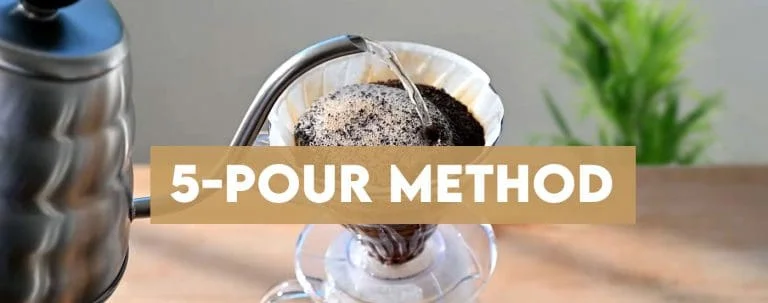Lungo Perfection: A Delicious Recipe and Expert Tips
Ever wondered why your lungo never turns out as good as the ones at your local coffee shop? I’m here to help.
I’ve been experimenting with 3 methods of making lungo to see what works best.
In this recipe, I’ll be sharing my findings along with step-by-step instructions for brewing delicious, balanced lungos at home.
Let’s get right into it.
What is a Lungo?
A lungo is a “longer” version of an espresso. Lungos are brewed with more water and therefore have a milder flavor. Lungo actually means “long” in Italian, the country the drink originates from.
You can clearly see the difference in volume between the ristretto, espresso, and lungo on this photo. By the way, here is a detailed article comparing the espresso with the lungo.

Unlike a ristretto or Americano, you don’t really see Lungos on coffee shop menus. However, I think they deserve more attention than they receive.
What I love about lungo is how it highlights different flavors. The slightly longer brewing time, paired with beans ground a bit coarser than normal, allows for unique floral and fruity aspects of the coffee beans to shine through – something you may miss out on with shorter extraction methods.
In terms of difficulty level, this recipe isn’t particularly challenging once you’ve mastered pulling a normal shot of espresso; however, getting the balance between sweetness and bitterness does require some experimentation:
- You need to dial in a coarser grind,
- targeting a slightly longer extraction time,
- with a larger yield than an espresso.

My first encounter with a lungo was actually coincidental. I’ve only heard of Nespresso machines making it, but the whole idea sounded off given my knowledge of how espressos are extracted. But when I saw a Lungo on a coffee shop’s menu, I decided to try it.
What did it taste like? I took my first sip and was surprised by how smooth and velvety the flavor was compared to a regular espresso. It was milder and slightly more bitter than what I was used to. It took me a few sips to adjust, but the bitterness actually helped to elevate the smoky and earthy notes of my coffee.
If an Americano is part of your daily routine, you might want to consider trying lungo from time to time, especially when you need that extra dose of caffeine. Yes, you read that right. The longer brew time results in more caffeine in a lungo than an espresso.
Equipment and Ingredients for a Lungo
- Espresso machine – to extract espresso shots.
- Grinder – to grind coffee beans for use in an espresso machine.
- 18 g of coffee beans – The type depends on your preference, but high-quality, light or medium-roasted single-origin beans work well with lungos.
- Coffee scale – To measure your grinds and yield.
Step-by-step Guide to Making a Lungo
I’ve tried three different methods for brewing a lungo:
- Use the same fine bean grind setting as for an espresso, and simply let the water run longer to create a longer drink. This results in an over-extracted, bitter lungo.
- Use a coarser grind setting and stick with the 25-30 second extraction time, as you would with an espresso. You will get a higher yield, but it tasted under-extracted.
- A hybrid method, which combines both of the above. We’ll double our yield and add ten more seconds of brew time to about 35 seconds.
The hybrid method works best, so we’ll be sticking with that one in this recipe.
1. Grind coffee beans using a slightly coarser than espresso fine
Start by grinding the coffee beans to a slightly coarser consistency than for a standard espresso shot. This grind size speeds up the flow of water through the grounds, without sacrificing taste.
2. Tamp the grounds, tare your scale, and start brewing
After grinding, carefully distribute the ground coffee evenly in your portafilter basket. Tamp down firmly and uniformly to create an even surface across the bed of coffee grinds.
Lock your portafilter in place, put your cup on your scale, tare, and start brewing.
3. Stop brewing after approximately 35 seconds
Use your coffee scale to measure how much liquid is being extracted during the brewing process. Stop brewing when you reach an output yield of about 70 grams, aiming for a 35 second brew time.
What is the correct ratio for a lungo? You are aiming for a yield of about 1:4, meaning 4 times as much liquid as the amount of coffee you used.
The resulting shot should be mild, sweet, and well-balanced, with notes of acidity upfront, a juicy mouthfeel, and a pleasant, slightly bitter aftertaste.
What kind of cup should a Lungo be served in?
Lungo is typically served in either a cappuccino cup or a glass cup.


Helpful Tips for Brewing a Lungo
Here are essential insights you’re going to need for a perfect lungo:
- If you have a refractometer to play with, you can test how much total dissolved solids are extracted in your coffee. Expect high but not over-extracted percentages around 23-24%. A 25% value is over-extracted.
- The yield of a lungo is 1:4 in around 35 seconds. You will have to dial it in, just like you do an espresso. Slightly modify the grind size, until you get these results.
- Be mindful of the bean selection. Although any coffee bean will do, the longer extraction times work best with fruity and floral-single-origin, light, or medium roasts.

Lungo Coffee Recipe
Ingredients
- 18 g coffee beans
Instructions
- Grind coffee beans using a coarser setting than what you would use for an espresso.
- Use a timer and scale to measure your yield as you brew your lungo.
- Stop brewing after approximately 35 seconds, aiming for a 1:4 coffee water ratio. With 18g coffee, that is a 72g yield.
Video
Notes
Summary
You should now have a pretty good idea of what a lungo is, how it differs from an espresso, and what variable you should be mindful of when brewing the drink. Remember that taste is subjective, so it’s important to find what works best for your palate through trial-and-error experiments.
How did it work out for you? Leave your comments below. I’d love to hear about new variations or ideas inspired by my guide.






